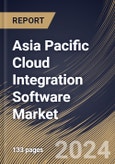Effective integration solutions become paramount as associations migrate their infrastructure and applications to cloud environments. Cloud integration software allows businesses to seamlessly connect disparate systems, ensuring a cohesive and efficient cloud ecosystem. The modern IT landscape is marked by the coexistence of on-premises and cloud-based applications, creating a complex web of technologies. It simplifies this complexity by providing a unified platform for managing and orchestrating diverse IT assets. Many organizations opt for hybrid cloud architectures, combining public and private cloud environments. It is crucial in harmonizing these hybrid setups, enabling data and application portability across different deployment models.
In the era of data-driven decision-making, organizations require real-time access to data from various sources. It facilitates the integration of data streams, supporting advanced analytics and business intelligence initiatives. Enterprises across industries are actively pursuing digital transformation initiatives to stay competitive. It is an enabler, ensuring that digital strategies can be seamlessly implemented by connecting legacy systems with modern cloud-based solutions. It enables the seamless integration of company applications, like Enterprise Resource Planning (ERP), Customer Relationship Management (CRM), and Human Resources Management (HRM) systems. This ensures a unified view of business processes and enhances overall operational efficiency.
The revenue of firms in the telecommunications sector in China surpassed 1.58 trillion yuan (233.38 billion U.S. dollars) in 2022, an annual growth rate of 8%, as the Ministry of Industry and Information Technology reported. China surpassed 2.31 million 5G base stations by the end of 2022, representing 60% of the worldwide total; of these, approximately 887,000 were constructed in 2022. 561 million individuals have adopted 5G mobile networks, which represents one-third of China's mobile phone user base. China has been actively rolling out and investing in 5G networks. Cloud integration plays a crucial role in deploying and managing 5G infrastructure, facilitating the integration of new technologies, and ensuring interoperability among various components. Therefore, the factors mentioned above will propel the market growth in this region.
The China market dominated the Asia Pacific Cloud Integration Software Market, By Country in 2022, and would continue to be a dominant market till 2030; thereby, achieving a market value of $685 million by 2030. The Japan market is exhibiting a CAGR of 14.3% during (2023 - 2030). Additionally, The India market would experience a CAGR of 15.8% during (2023 - 2030).
Based on Type, the market is segmented into Infrastructure as a Service (IaaS), Software as a Service (SaaS), and Platform as a Service (PaaS). Based on Enterprise Size, the market is segmented into Large Enterprises, and Small & Medium-sized Enterprises. Based on End Use, the market is segmented into IT & Telecommunication, Manufacturing, Retail & E-commerce, BFSI, Healthcare, and Others. Based on countries, the market is segmented into China, Japan, India, South Korea, Singapore, Malaysia, and Rest of Asia Pacific.
The market research report covers the analysis of key stake holders of the market. Key companies profiled in the report include Salesforce, Inc., IBM Corporation, Microsoft Corporation, Amazon Web Services, Inc. (Amazon.Com, Inc.), Citrix Systems, Inc. (Cloud Software Group, Inc.), Oracle Corporation, Informatica Inc., Verizon Communications, Inc., VMware, Inc. (Broadcom Inc.), and DXC Technology Company
Scope of the Study
Market Segments Covered in the Report:
By Type- Infrastructure as a Service (IaaS)
- Software as a Service (SaaS)
- Platform as a Service (PaaS)
- Large Enterprises
- Small & Medium-sized Enterprises
- IT & Telecommunication
- Manufacturing
- Retail & E-commerce
- BFSI
- Healthcare
- Others
- China
- Japan
- India
- South Korea
- Singapore
- Malaysia
- Rest of Asia Pacific
Key Market Players
List of Companies Profiled in the Report:
- Salesforce, Inc.
- IBM Corporation
- Microsoft Corporation
- Amazon Web Services, Inc. (Amazon.Com, Inc.)
- Citrix Systems, Inc. (Cloud Software Group, Inc.)
- Oracle Corporation
- Informatica Inc.
- Verizon Communications, Inc.
- VMware, Inc. (Broadcom Inc.)
- DXC Technology Company
Unique Offerings
- Exhaustive coverage
- The highest number of Market tables and figures
- Subscription-based model available
- Guaranteed best price
- Assured post sales research support with 10% customization free
Table of Contents
Companies Mentioned
- Salesforce, Inc.
- IBM Corporation
- Microsoft Corporation
- Amazon Web Services, Inc. (Amazon.Com, Inc.)
- Citrix Systems, Inc. (Cloud Software Group, Inc.)
- Oracle Corporation
- Informatica Inc.
- Verizon Communications, Inc.
- VMware, Inc. (Broadcom Inc.)
- DXC Technology Company








